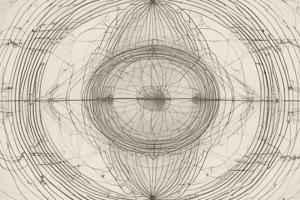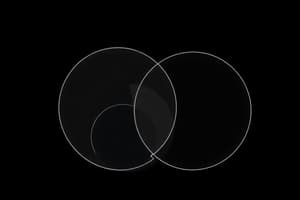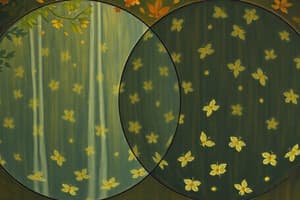Podcast
Questions and Answers
What is the purpose of using Venn diagrams in problem-solving?
What is the purpose of using Venn diagrams in problem-solving?
- To exclude certain elements from a universal set.
- To visualize and simplify complex relationships between different groups of data. (correct)
- To complicate data and relationships for better analysis.
- To represent data linearly, enhancing sequential processing.
In a Venn diagram, what does the area outside the circles but within the rectangle represent?
In a Venn diagram, what does the area outside the circles but within the rectangle represent?
- Elements that are in all of the sets.
- The intersection of all sets.
- Elements that are in none of the sets. (correct)
- The union of all sets.
Given two sets, A and B, and their symmetric difference (A Δ B), which elements are included in A Δ B?
Given two sets, A and B, and their symmetric difference (A Δ B), which elements are included in A Δ B?
- Elements common to both A and B.
- Elements in A or B, including those in both.
- Elements in A but not in B.
- Elements in either A or B, but not in both. (correct)
When solving problems with Venn diagrams, which section should be filled in first?
When solving problems with Venn diagrams, which section should be filled in first?
In a class of 40 students, 20 like apples, 15 like bananas, and 5 like both. How many students like neither apples nor bananas?
In a class of 40 students, 20 like apples, 15 like bananas, and 5 like both. How many students like neither apples nor bananas?
Which of the following is a benefit of using Venn diagrams?
Which of the following is a benefit of using Venn diagrams?
What is a common mistake to avoid when using Venn diagrams for problem-solving?
What is a common mistake to avoid when using Venn diagrams for problem-solving?
What should you do if a problem involves more than three sets when using Venn diagrams?
What should you do if a problem involves more than three sets when using Venn diagrams?
If set A represents students who like math and set B represents students who like science, how do you represent students who like either math or science, but not both, using set operations?
If set A represents students who like math and set B represents students who like science, how do you represent students who like either math or science, but not both, using set operations?
Which of the following is a key tip for creating effective Venn diagrams?
Which of the following is a key tip for creating effective Venn diagrams?
Flashcards
What are Venn diagrams?
What are Venn diagrams?
Pictorial representations of sets and their relationships using overlapping shapes, usually circles, within a rectangle representing the universal set.
What is a Union (A ∪ B)?
What is a Union (A ∪ B)?
Includes all elements that are in A, in B, or in both.
What is an Intersection (A ∩ B)?
What is an Intersection (A ∩ B)?
Includes all elements that are common to both A and B.
What is a Complement (A')
What is a Complement (A')
Signup and view all the flashcards
What is a Symmetric Difference (A Δ B)?
What is a Symmetric Difference (A Δ B)?
Signup and view all the flashcards
Steps for problem-solving with Venn diagrams
Steps for problem-solving with Venn diagrams
Signup and view all the flashcards
Benefits of using Venn diagrams
Benefits of using Venn diagrams
Signup and view all the flashcards
Common mistakes to avoid with Venn Diagrams
Common mistakes to avoid with Venn Diagrams
Signup and view all the flashcards
Study Notes
- Venn diagrams offer a visual representation of sets and their relationships using overlapping shapes, typically circles, inside a rectangle that symbolizes the universal set
- They aid in visually organizing data to simplify understanding relationships between different groups
- Overlapping circles in Venn diagrams illustrate the relationships between sets
- A rectangle represents the universal set, encompassing all elements under consideration
- Each circle corresponds to a set, while overlapping areas denote the intersection of sets
- The area outside the circles, yet within the rectangle, signifies elements outside any of the defined sets
Basic Set Operations
- Union (A ∪ B): Includes all elements in A, in B, or in both A and B
- Intersection (A ∩ B): Includes elements common to both A and B
- Complement (A'): Includes all elements in the universal set not in A
- Difference (A - B): Includes elements in A but not in B
- Symmetric Difference (A Δ B): Includes elements in either A or B, but not in both; can also be expressed as (A ∪ B) - (A ∩ B)
Problem-Solving with Venn Diagrams
- Used in solving problems related to set theory, logic, and data analysis
- Help visualize and simplifying complex relationships among data groups
- Identify sets, draw the Venn diagram with overlapping circles when solving problems
- Fill the Venn diagram, begin with the intersection of all sets
- Complete the remaining sections using provided data and set operations
- Use the diagram to answer questions, like finding the number of elements in a set or the intersection of sets
Applications of Venn Diagrams
- Used in mathematics for illustrating set theory concepts, probability, and statistics
- Used in logic for analyzing arguments, establishing validity, and depicting logical relationships
- Used in computer science for representing data structures, database queries, and algorithm design
- Used in business for market analysis, customer segmentation, and decision-making processes
- Used in education for teaching concepts, information organization, and improved comprehension
Steps for Solving Problems Using Venn Diagrams
- Read and Understand the Problem: Identify sets and relationships
- Draw the Venn Diagram: Include appropriate overlapping circles and labels
- Fill in the Intersections: Start with the intersection of all sets
- Use the Given Information: Perform necessary calculations for all sets
- Answer the Questions: Use the information to answer questions
Example Problem
- In a class of 30 students, 15 play football, 10 play basketball, and 5 play both football and basketball.
- Draw a Venn diagram to represent this scenario
- Find out how many students play neither sport
Solution
- Draw two overlapping circles labeled football (F) and basketball (B) inside a rectangle (U) for the universal set of 30 students
- The intersection of F and B is 5 (students playing both sports)
- For football circle F, the remainder is 15 - 5 = 10
- For basketball circle B, the remainder is 10 - 5 = 5
- Numbers in the circle added: 10 (football only) + 5 (both) + 5 (basketball only) = 20
- Subtract the total number for the unrepresented number of students: 30 - 20 = 10
- 10 students play neither football nor basketball
Benefits of Using Venn Diagrams
- Simplify complex problems via relationship visualization
- Logically organize information for understanding and remembering
- Solve problems in set theory, logic, and data analysis effectively
- Enhance communication and collaboration by visually representing data and relationships
- Improve decision-making with clear overviews of information
Common Mistakes to Avoid
- Misinterpreting problem statements and incorrectly identifying sets and relationships
- Filling in the Venn diagram incorrectly leading to inaccurate results
- Neglecting to double-check calculations and logic for errors
- Overlooking the universal set and external elements
- Overcomplicating the diagram affecting interpretation
Advanced Venn Diagrams
- Use more complex diagrams when involving more than three sets
- Drawing these diagrams and filling them accurately can be challenging
- Use colors or shading when distinguishing regions in the diagram
- Create variations such as Euler diagrams, where not all intersections are represented
Tips for Creating Effective Venn Diagrams
- Use clear labels making it easy to understand the meaning of each circle/set
- Select circle sizes to reflect relative sizes of sets
- Correctly use overlapping circles to represent set intersections
- Use varying colors to distinguish regions of the diagram
- Keep the diagram simple and easy to understand, avoiding unnecessary details
Studying That Suits You
Use AI to generate personalized quizzes and flashcards to suit your learning preferences.




